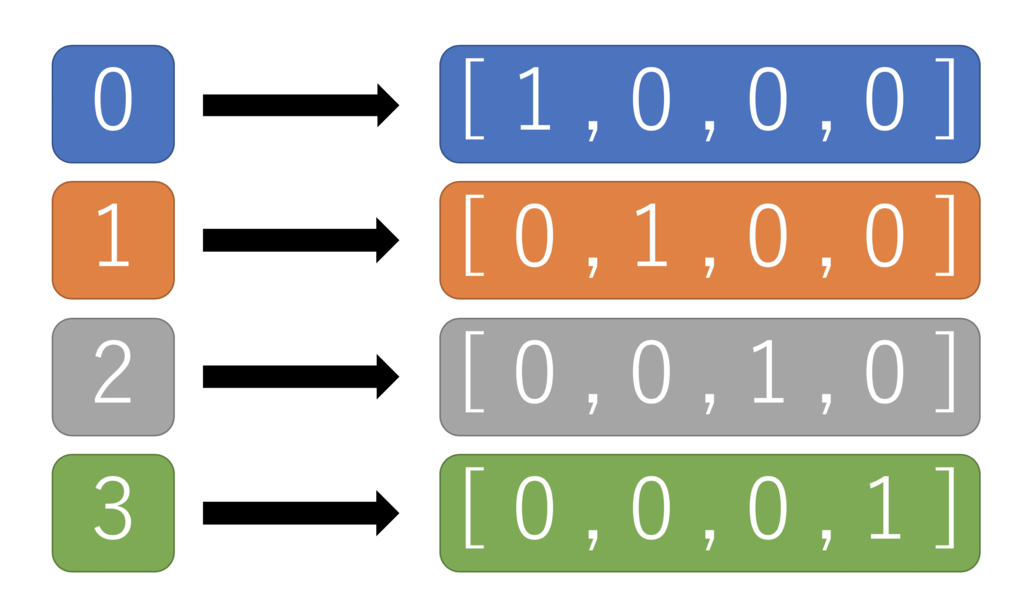One-hotベクトルを整数値のベクトルにnumpyでデコードする
どうもたっきーです.これはメモ.
はじめに

Kerasではkeras.utils.np_utils の to_categorical()という関数を用いれば簡単にOne-hotベクトルが生成できる.
これで多クラス分類の場合は、categorical_crossentropyを計算できる.
しかし,これを使って混合行列とかを表示したいとき,sklearn.metrics.confusion_matrix()に渡す値がOne-hotベクトルだと無理っぽくてラベルの整数値の配列を渡さなければいけないらしい.
(
つまり,
array([[ 1., 0., 0., ..., 0., 0., 0.],
[ 1., 0., 0., ..., 0., 0., 0.],
[ 1., 0., 0., ..., 0., 0., 0.],
...,
[ 0., 0., 0., ..., 0., 0., 1.],
[ 0., 0., 0., ..., 0., 0., 1.],
[ 0., 0., 0., ..., 0., 0., 1.]], dtype=float32)
みたいなOne-hotベクトルじゃなくて,
array([0, 0, 0, ..., 9, 9, 9])
のようなラベルの整数値の配列じゃないとダメってこと(この場合だと0〜9の10クラスの分類問題)
)
じゃあ,to_categorical()でOne-hotベクトル化する前の配列を使えばいいじゃん?ってなると思うけど,One-hotベクトル化した後のやつをnp.save()で保存していたので,元のクラスの整数値の配列は保存してなかった.
そこで”One-hotベクトル” → ”クラスの整数値”ってどうやって変換すんじゃい!!!!ってなったので調べたりしたのでメモる.
やりかた
np.argmax(one_hot, axis=1)でできるっぽい.
np.where()を使う方法もあるっぽいけど,np.argmax()のほうが分かりやすいのでこっちのがオススメである.
つまり,
Confusion matrix — scikit-learn 0.20.0 documentation
のようなやつで使いたいときは↓のように書けば良い.
%matplotlib inline import os import numpy as np import matplotlib.pyplot as plt from sklearn.metrics import confusion_matrix import itertools """ Kerasのモデルの定義や学習は省略 """ labels_pred = model.predict_classes(x_test,verbose=0) def plot_confusion_matrix(cm, classes, title='Confusion matrix', cmap=plt.cm.Blues): """ This function prints and plots the confusion matrix. Normalization can be applied by setting `normalize=True`. """ cm_normalize = cm.astype('float') / cm.sum(axis=1)[:, np.newaxis] plt.imshow(cm_normalize, interpolation='nearest', cmap=cmap) plt.title(title) plt.colorbar() tick_marks = np.arange(len(classes)) plt.xticks(tick_marks, classes, rotation=90) plt.yticks(tick_marks, classes) thresh = cm.max() / 2 for i, j in itertools.product(range(cm.shape[0]), range(cm.shape[1])): plt.text(j, i, format(cm[i, j], "d"), horizontalalignment="center", color="white" if cm[i, j] > thresh else "black") plt.ylabel('True label') plt.xlabel('Predicted label') plt.tight_layout() # Compute confusion matrix cnf_matrix = confusion_matrix(np.argmax(y_test, axis=1), labels_pred) np.set_printoptions(precision=2) # Plot non-normalized confusion matrix plt.figure() plot_confusion_matrix(cnf_matrix, classes=class_name_modelnet, title='Normalized_confusion_matrix') plt.savefig('Normalized_confusion_matrix.svg') plt.show()
まとめ
np.argmax([One-hotベクトル], axis=1)で,
”One-hotベクトル” → ”クラスの整数値” に変換できる.
感想
どーせkerasのmodel.fit()に渡す配列はOne-hotベクトルじゃないとダメだからOne-hotベクトルに変換したやつをnp.save()で保存して使お!って思ってたけど,変換前のヤツも何気よく使うので困った.
てか,model.fit()に渡すのはOne-hotじゃなきゃいけないのに,model.predict_classes()で返ってくるのはラベルの整数値の配列なの,扱いにくくないか...?
numpy力が強いとコード書くとき強えなって思った(こなみかん)
今日学内コンビニで見つけたとても美味しいやつ
強い…! pic.twitter.com/fxfvSFJwME
— めめめっ (@tacky0612) October 18, 2018

ゼロから作るDeep Learning ―Pythonで学ぶディープラーニングの理論と実装
- 作者: 斎藤康毅
- 出版社/メーカー: オライリージャパン
- 発売日: 2016/09/24
- メディア: 単行本(ソフトカバー)
- この商品を含むブログ (18件) を見る

直感 Deep Learning ―Python×Kerasでアイデアを形にするレシピ
- 作者: Antonio Gulli,Sujit Pal,大串正矢,久保隆宏,中山光樹
- 出版社/メーカー: オライリージャパン
- 発売日: 2018/08/17
- メディア: 単行本(ソフトカバー)
- この商品を含むブログを見る